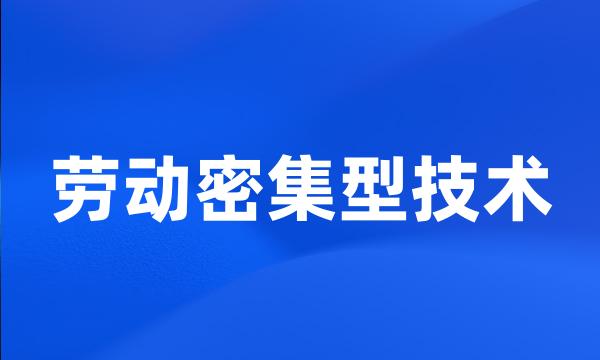劳动密集型技术
- 网络labor-intensive technique
 劳动密集型技术
劳动密集型技术-
城市又是先进生产技术积聚的场所,城市化的过程就是劳动密集型技术向人力资本密集型技术转移的过程。
Moreover city is the accumulation place of advanced production technology . Urbanization process is labor-intensive technology to human capital-intensive technology transfer process .
-
造船业作为劳动密集型、技术密集型和资金密集型的产业,正在逐渐向中国转移。
Shipbuilding industry as a labor-intensive , technology-intensive and capital-intensive industry is shifting to China gradually .
-
在企业从劳动密集型到技术密集型、知识密集型的转变过程中,自动化生产技术是必经之路。
Automated production technology is the only path for enterprises ' transition from the labor-intensive to technology-intensive .
-
项目的新型收费模式和人才培养模式对其他劳动密集型行业技术人才的培养均有借鉴意义。
The new pricing model and talent training model for other labor-intensive industry and technical personnel training are reference .
-
茶叶生产由劳动密集型转向技术密集型、由人工手采转向机械采摘是世界茶业发展的主流。
Tea production from labor-intensive to technology-intensive , from hand pluck to mechanical harvest is the mainstream of the world tea industry development .
-
受国家政策、市场开放的影响,重庆市工业就业结构的变动将更加剧烈,并由劳动密集型向技术密集型快速演变。
Influenced by state policies and market openness , the change of industrial employment structure is more serious and evolution from labor-intensive to technology-intensive forms multiple employment structure .
-
伴随着中国经济的转型期,中国的制造业也从以往的劳动密集型向技术密集型进行转换,智能装备在其中起到了举足轻重的作用。
Chinese manufacturing converts from the traditional labor-intensive to the technology-intensive in the period of the economic transition of China and the intelligent equipment plays an important role .
-
民营企业急需加快从资本劳动密集型向技术密集型转变,注重资本的多元性选择,同时更应关注企业资本变量的内部结构,特别是科技资本要素的内部整合。
Private sector is in urgent need to transform from capital-labor intensive enterprises to technology-intensive enterprise and pay attention to multiple choice of capital , especially internal integration of scientific and technological capital elements .
-
随着中国作为全球重要制造基地地位的逐渐形成和加强,我国产业结构已经进入由劳动密集型向技术、知识密集型转变的新阶段,并吸引到更多国外投资。
As China is establishing the status as a global manufacturing center , its industrial structure has rapidly changed from labor-intensive stage to technology , knowledge-intensive stage and attracted more and more foreign investment .
-
随着专业化程度的加深,中国比较优势长期维持在劳动密集型和低技术含量制成品上,并且优势不断加强。
With the deepening of specialization , China 's comparative advantage long-term maintains in labor-intensive and low technology products and the comparative advantage is strengthened .
-
改革开放二十多年来,在经济国际化、全球化的浪潮下,我国经济已经开始了由劳动密集型经济向技术密集型、资金密集型经济,由粗放型经济向集约型经济转变的过程。
Under the influence of internationalization and globalization , since 20 years ' reform and open , Chinese economy has been converting from labor densified to technology and capital densified , and from extensive to intensive .
-
然而,印度应该利用其在劳动密集型和低技术含量制造业中的比较优势,来推动制造业充当本国的主要增长引擎,这也会帮助其更好地消化日益增多的劳动力。
However , India should utilize its comparative advantage in labour intensive and low-skilled manufacturing to fire up the manufacturing sector as a key engine of growth , which will also help better absorb the growing labour force .
-
文章认为:人均占有耕地少,是中国农业的劣势所在,劳动力多又是突出优势;其次,劳动密集型产品、技术密集型产品、区位优势产品也具有比较优势。
It is argued that : less cultivated land per head is our disadvantage but more labour force is our advantage . Further more , the products of intensive labour force and technology , that of area superiority are also our comparative advantage .
-
然而,由于韩国对华直接投资是出于自身产业结构升级的需要,因而其直接投资的往往是在韩国己丧失比较优势的劳动密集型、低技术、低附加值的产业。
However , aiming to promote their industry structure through direct investment to China , investment is concentrating on the labor-intensified industry with low technology and value-added . In addition , Korea has regarded Chinese industry as one sector in its vertical labor-division system .
-
第二,劳动密集型和成熟适用技术产业作为对外直接投资的主导产业。
Secondly , labor-intensive industry and applicable mature technology should be the leading industry .
-
在此基础之上提出了发展劳动密集型产业和自主技术创新的必要性。
According to this , it is necessary to put forward the development about the labor intensive type industry and independent technique .
-
知识经济背景下的机械企业不再是以往单纯的劳动密集型企业,而是技术密集与劳动密集的结合。
Mechanical enterprise is no longer pure labor-intensive in the knowledge economic environment , but also the combine of labor-intensive and technology-intensive .
-
随着经济的增长,产业结构正在加快从简单劳动密集型产品向资本技术密集型产品和自有品牌和自主研发型产品的转变。
When economy is growing , industrial structure accelerates its changes from simple labor intensive products to capital intensive and technology intensive products even OBM and ODM products .
-
从得出结论可以看出,劳动密集型产业行业的技术进步较低,但技术效率较高:资本密集型和技术密集型产业行业的技术进步较高,而技术效率较低。
The paper can concluded that the technological progress of the labor-intensive industries is lower , but higher technical efficiency ; the technological progress of the capital-intensive and technological-intensive industries is higher , but technical efficiency is lower .
-
由于技术先进的产业往往也是资本或人力资本密集的产业,因此中国入世后就面临更多地利用现有比较优势来发展传统劳动密集型产业还是推动技术进步发展高新技术产业的矛盾。
As technically advanced industry is usually capital or human capital intensive , China would be faced with the contradiction between exploiting the present relative advantage to develop traditional labor intensive industries and accelerating technical progress to develop high and new tech industries .
